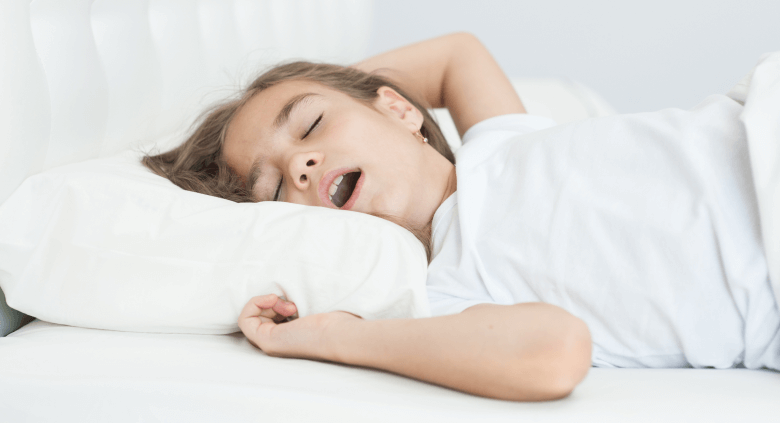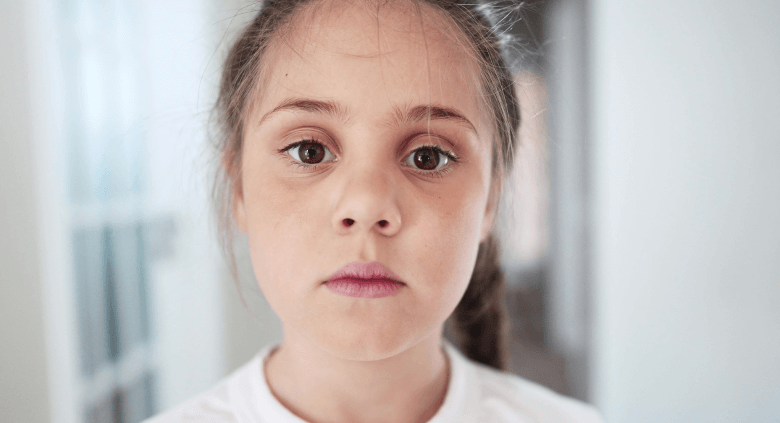
Sleep Apnea
Sleep apnea is a sleep disorder characterized by pauses in breathing during sleep that last for several seconds or longer. These pauses can occur multiple times throughout the night and can lead to disruptions in sleep, decreased oxygen levels in the body, and a range of health issues.
In children, sleep apnea can be caused by a variety of factors, including an underdeveloped jaw, enlarged tonsils or adenoids, obesity, and certain medical conditions such as cerebral palsy or Down syndrome. Symptoms of sleep apnea in children can include snoring, gasping for air during sleep, restlessness, and daytime sleepiness.
Sleep Disordered Breathing
Sleep-disordered breathing (SDB) in children refers to breathing irregularities during sleep, including snoring and sleep apnea, which can have significant health implications. One contributing factor to SDB is mouth breathing. Habitual mouth breathing can lead to a chain of physiological changes, including altered tongue posture and jaw position. This can result in the narrowing of the upper airway, making it more susceptible to partial blockage during sleep. As a result, proper airflow is compromised, potentially leading to disruptions in breathing patterns and inadequate oxygen intake. Recognizing the connection between mouth breathing and SDB is crucial in addressing and managing these issues to ensure optimal sleep quality and overall well-being in children. Toothpillow addresses mouth breathing, training the tongue to stay in the roof of the mouth and preventing or fixing symptoms of SDB.
Large Tonsils/Adenoids
Tonsils can enlarge due to chronic mouth breathing. When a person breathes through their mouth, particularly during sleep, the air flow can cause the tonsils to become irritated and swollen. Chronic mouth breathing can also lead to dehydration of the nasal passages, which can cause the tonsils to enlarge in an attempt to humidify and filter the air entering the lungs. Over time, this repeated irritation and swelling can cause the tonsils to become persistently enlarged, leading to a narrowing of the airway and potentially causing sleep apnea, a common sleep disorder where breathing is disrupted during sleep.

Sleep Talking/Walking
Children with sleep-disordered breathing, such as sleep apnea, often experience repeated awakenings and difficulty breathing during sleep, leading to increased arousal from deep sleep. This increased arousal can result in episodes of sleepwalking and sleep talking, characterized by walking and talking during sleep without full consciousness. Additionally, sleep-disordered breathing can also cause fragmentation of sleep, reducing the amount of deep sleep and increasing the risk of sleepwalking and sleep talking. Proper diagnosis and treatment can help to reduce the risk of sleepwalking and sleep talking and improve overall sleep quality.
ADD/ADHD
Attention-deficit/hyperactivity disorder (ADHD) is a neurodevelopmental disorder characterized by difficulties in sustaining attention, controlling impulses, and managing hyperactivity. Recent research suggests a possible link between sleep-disordered breathing (SDB) and the development or exacerbation of ADHD symptoms in children. SDB, which includes conditions like snoring and sleep apnea, can lead to fragmented sleep and intermittent drops in oxygen levels, impacting the child's overall sleep quality. These disruptions can potentially contribute to cognitive and behavioral issues, including inattentiveness, hyperactivity, and impulsivity—core symptoms of ADHD. The disrupted sleep patterns caused by SDB might create an environment where neurological and cognitive processes are affected, potentially contributing to the manifestation of ADHD symptoms. Addressing and treating underlying sleep-disordered breathing in Toothpillow treatment could, in turn, have a positive impact on managing or alleviating ADHD symptoms in children.
Bedwetting
Bedwetting can be a sign of sleep-disordered breathing in children. Children with sleep-disordered breathing often experience repeated awakenings and difficulty breathing during sleep, leading to increased arousal from deep sleep. This increased arousal can interfere with the normal bladder control mechanisms, leading to bedwetting.
Additionally, sleep-disordered breathing can also cause decreased production of antidiuretic hormone (ADH), which regulates urine production during sleep, further contributing to bedwetting. Proper diagnosis and treatment of sleep-disordered breathing can help to reduce the risk of bedwetting and improve overall sleep quality.
Digestion
Mouth breathing, particularly during sleep, can potentially contribute to indigestion through its impact on the digestive process. Breathing through the mouth instead of the nose can lead to reduced saliva production, which plays a crucial role in the initial stages of digestion. Saliva contains enzymes that help break down food and initiate the digestive process in the mouth. Additionally, breathing through the mouth can lead to swallowing more air, which can result in increased gas production in the stomach. This excess air can contribute to feelings of bloating and discomfort, potentially leading to indigestion. Moreover, nasal breathing encourages a relaxation response in the body, which is conducive to proper digestion, while mouth breathing may disrupt this balance and potentially hinder the efficient functioning of the digestive system.
Crooked Teeth (Malocclusion)
Mouth breathing can contribute to the development of crooked teeth and misaligned dental arches in several ways. When a child habitually breathes through the mouth instead of the nose, it can disrupt the natural growth and positioning of the jaw and facial bones during crucial developmental stages. The tongue usually rests against the palate, aiding in its proper growth and alignment. However, mouth breathing can lead to a lowered tongue posture and a lack of proper pressure against the upper palate, causing it to narrow and resulting in inadequate space for teeth to erupt. This can lead to dental crowding and misalignment. Additionally, mouth breathing can affect the balance of oral muscles, potentially leading to an imbalanced force on the teeth, contributing to malocclusions. Early intervention with Toothpillow treatment to address mouth breathing can help mitigate these orthodontic issues and promote proper facial and dental development.

Snoring
Snoring is a common sign of sleep-disordered breathing, particularly obstructive sleep apnea (OSA). OSA is a condition in which the airway becomes partially or completely blocked during sleep, leading to repeated awakenings and difficulty breathing. These awakenings can cause the muscles in the throat to tense, leading to vibration and the sound of snoring. Snoring can be an indicator of sleep-disordered breathing, and is often accompanied by other symptoms such as choking or gasping for air, restless tossing and turning during sleep, and excessive daytime sleepiness. Proper diagnosis and treatment of sleep-disordered breathing can improve sleep quality and reduce the risk of associated health problems.
Asthma
Asthma and sleep disorder breathing can be related, with each condition potentially worsening the symptoms of the other. People with asthma are more likely to have sleep apnea, a common sleep disorder where breathing is disrupted during sleep. The repeated awakenings and difficulty breathing during sleep can exacerbate asthma symptoms and lead to increased inflammation in the airways. Conversely, sleep apnea can also worsen asthma symptoms by causing chronic fatigue, reducing the ability of the lungs to exchange oxygen and carbon dioxide, and leading to increased oxidative stress. Proper treatment of both conditions is important for improving overall health and reducing the severity of symptoms.
Night Terrors
Night terrors can be a sign of sleep-disordered breathing in children. Children with sleep-disordered breathing often experience repeated awakenings and difficulty breathing during sleep, leading to increased arousal from deep sleep. This increased arousal can result in episodes of night terrors, characterized by screaming, thrashing, and a sense of terror during sleep. Additionally, sleep-disordered breathing can also cause fragmentation of sleep, reducing the amount of deep sleep and increasing the risk of night terrors. Proper diagnosis and treatment of sleep-disordered breathing can help to reduce the risk of night terrors and improve overall sleep quality.
Speech Results
Children with speech delays often have underlying oral muscle dysfunction, including incorrect swallowing and tongue-thrusting patterns, which can contribute to the development of sleep-disordered breathing. When the airway becomes obstructed during sleep, it can lead to fragmented and poor quality sleep, affecting the child's ability to concentrate, learn, and develop speech and language skills. In some cases, treating sleep-disordered breathing can improve speech and language development in children. Additionally, myofunctional therapy to correct underlying oral muscle dysfunction can also help to improve breathing during sleep and reduce the risk of sleep-disordered breathing.

Depression/Anxiety
Sleep disorder breathing can disrupt normal sleep patterns, leading to poor quality sleep and increased stress on the body. This can contribute to the development of depression and anxiety, as well as other mental health issues. OSA is a sleep disorder that occurs when the airway becomes blocked during sleep, leading to pauses in breathing and reduced oxygen levels in the body. This can lead to repeated arousals throughout the night, disrupting normal sleep patterns and leading to poor quality sleep. The repeated arousals and poor quality sleep associated with OSA can increase stress on the body and contribute to the development of depression and anxiety.
Persistent Cavities
Cavities can develop as a result of mouth breathing due to the decreased production of saliva. Saliva helps to neutralize the acids produced by bacteria in the mouth, keeping the teeth healthy. When a person breathes through their mouth, particularly during sleep, the air flow can cause the mouth to become dry, leading to decreased saliva production. The lack of saliva can allow the bacteria in the mouth to thrive, leading to an increased risk of cavities. In contrast, nasal breathing helps to humidify and filter the air, reducing the risk of dry mouth.
Grinding/Clenching
Grinding and clenching of teeth (bruxism) is often a manifestation of abnormal muscle activity in the face, jaw and throat, which can be caused by repeated arousal from sleep and attempts to open the airway. Children with sleep-disordered breathing often experience repeated awakenings and difficulty breathing during sleep, leading to increased muscle tension in the face and jaw. This tension can result in grinding and clenching of the teeth during sleep, causing pain and damage to the teeth and jaw. Additionally, bruxism can also contribute to sleep-disordered breathing by narrowing the airway, leading to further awakenings and difficulties breathing.
Headaches
Headaches can be related to sleep disorder breathing as poor quality sleep and low oxygen levels can cause tension headaches and migraines. Obstructive sleep apnea (OSA), a common sleep disorder where breathing stops and starts during sleep, is associated with frequent waking and fragmentation of sleep which can trigger headache.
Ear Infections
When a child's jaw is small, it can result in a narrow or constricted upper airway, which can make it difficult for air to pass through freely. This can lead to an increased likelihood of snoring and sleep-disordered breathing, both of which can contribute to the development of ear infections.
The Eustachian tube, which connects the middle ear to the back of the throat, is responsible for equalizing air pressure in the ear and draining fluids from the middle ear. However, if the upper airway is narrow, the Eustachian tube may not function properly, leading to fluid buildup in the middle ear and an increased risk of ear infections.
Food Avoidance
When a child has an underdeveloped jaw, it can result in a smaller or more recessed lower jaw, which can affect the alignment of the teeth and the function of the temporomandibular joint (TMJ). This can make it more difficult to chew food properly, leading to discomfort or pain while eating, as well as a greater risk of choking or aspiration.
In some cases, children with an underdeveloped jaw may also have an overbite or an open bite, which can further contribute to difficulties with chewing and swallowing. As a result, children with an underdeveloped jaw may avoid certain foods that are more difficult to chew, such as meats, raw vegetables, or tough grains, and may prefer softer or more processed foods that are easier to eat.